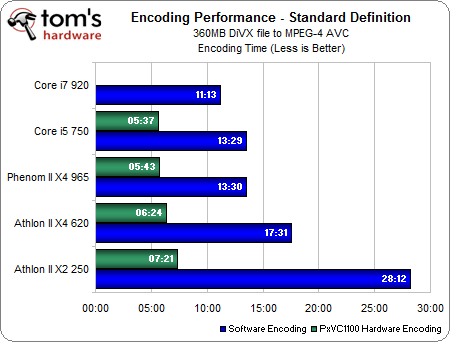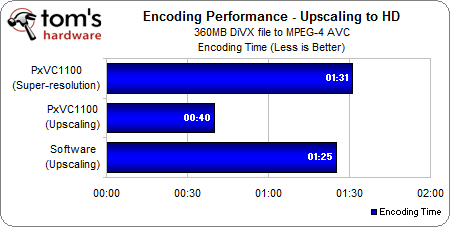The WinFast PxVC1100 Video Transcoding Card: Worth The Price?
Encoding Performance Benchmarks
We're going to start off the benchmarks with what we think is the most important statistic: encoding speed. Using five CPUs with and without the assistance of the WinFast PxVC1100 card, here are the results:
There are two main things we can see very quickly. First, the TMPGEnc 4.0 XPress application takes good advantage of threading. See how poorly the Athlon II X2 250 is performing, despite its high 2.9 GHz clock speed? Secondly, note just how quickly the WinFast PxVC1100 encodes video, even when paired to the Athlon II X2 processor.
The lesson here is that if you're planning a PC build with a primary function of video encoding, the speed advantage of the WinFast PxVC1100 is very hard to ignore, regardless of the CPU that you choose to deploy in your machine. Even the slowest Athlon II X2 250 managed to encode the video in about seven and a half minutes using the WinFast card, compared to about five and a half minutes with the Core i5-750/WinFast PxVC1100 combo. For comparison purposes, the Core i7-920 completed the task in just over 11 minutes without the SpursEngine helping it along.
We'll explore the cost/benefit ratio below, but for now let's have a look at the video up-scaling performance that the SpursEngine processor offers. We encoded a short 720x480 video sample into the higher HD 1920x1080 resolution using the CPU, the WinFast card, and then the WinFast card again in conjunction with the super-resolution option:
Enabling super-resolution increased the time to encode the video by more than two times as long, which was even slightly longer than with the pure-CPU encoding method. This isn't so bad if the end result is stunning, but if it doesn't provide a notable increase in quality, then this is a hard pill to swallow.
Next, we're going to have a look at the image-quality aspects of software versus hardware encoding.
Get Tom's Hardware's best news and in-depth reviews, straight to your inbox.
Current page: Encoding Performance Benchmarks
Prev Page Test Systems And Benchmarks Next Page Image Quality ComparisonDon Woligroski was a former senior hardware editor for Tom's Hardware. He has covered a wide range of PC hardware topics, including CPUs, GPUs, system building, and emerging technologies.
-
paxiam I think for someone who does use their PC for encoding on a regular basis, this would certainly be a welcome addition, but otherwise, forget it.Reply -
paxiam I think for someone who does use their PC for video encoding on a regular basis, this would certainly be a welcome addition (the price is reasonable), but otherwise, forget it.Reply -
SpadeM These miscellaneous type of articles is what brightens up my day. Good to know that there aren't many products that launch and slip between the cracks of processor/graphics wars. Great job, nice article!Reply -
kumaiti Any info on future software support for this card? This card would be extremely useful if plug-ins for other video editor could be made.Reply -
4745454b Considering AMD has all but abandoned AVIVOm, the better question to ask is how this compares to CUDA. From what I've seen there aren't any problems with the output file. $200 is a bit much but at least it comes with the software. For those that have the $$$ to spare and do the encoding work, this is a big time saver. You could get the 620, mobo, and the card for probably about the same price as the 920 and a good Mobo. The difference is this setup will encode faster, and you can use the computer to do other things while encoding. I don't remember 100% for sure about it, but I think it will use less power as well.Reply -
apache_lives hmmm get the feeling this will go the way of the dedicated physx (only) cards...Reply
what we need is a more GENERALISED co-processor card/device for this type of workload and many other uses, Intel's Larrabee had a good *idea* going - easily programmable, multi-purpose etc -
g00ey I was rather thinking that this hardware could be useful in portable media players where it is designed to consume less power and allow playback of all video formats out there.Reply
Moreover, this could also be useful in HD video cameras that are either stand-alone HD video cams or fitted into mobile phones (such as the Samsung Omnia HD) or digital snapshot cameras.
I'm also thinking about its capabilities to be used in Live video applications that is streamed over the internet, either professional or teleconference applications such as SkypeHD.

